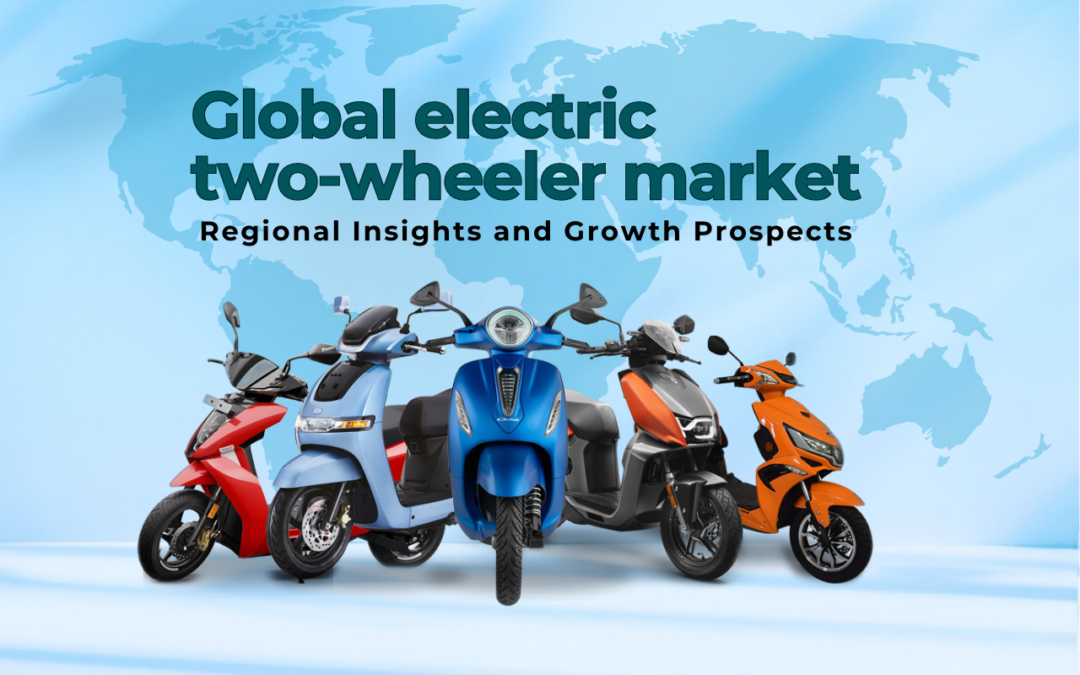The global electric two-wheeler market has witnessed remarkable growth in recent years, driven by the increasing demand for sustainable transportation solutions, stringent emission regulations, and advancements in battery technology. This blog explores the regional dynamics and future growth prospects of the electric two-wheeler market across key regions.
1. Asia-Pacific: The Dominant Force
Asia-Pacific holds the lion’s share in the global electric two-wheeler market, with countries like China, India, and Vietnam leading the charge. This region’s dominance is attributed to factors such as large population bases, rapid urbanization, supportive government policies, and a strong manufacturing ecosystem.
- China: As the largest market globally, China benefits from strong government support, extensive charging infrastructure, and dominant local manufacturers like Niu Technologies and Yadea. The country’s aggressive policies to curb air pollution have significantly boosted electric two-wheeler adoption. The Chinese government offers subsidies, tax incentives, and preferential policies to encourage electric vehicle (EV) usage. Additionally, the rapid expansion of charging stations, coupled with urban restrictions on gasoline-powered two-wheelers, has accelerated market growth. Chinese consumers are increasingly favoring high-tech electric scooters with features like GPS tracking, smart connectivity, and enhanced battery life.
- India: Driven by rising fuel prices, urban congestion, and government incentives such as the FAME II scheme, India is experiencing rapid growth in electric scooter sales. Companies like Ola Electric and Hero Electric are expanding their product offerings to meet growing demand. The Indian government’s push towards electric mobility through initiatives like the National Electric Mobility Mission Plan (NEMMP) and Faster Adoption and Manufacturing of Hybrid and Electric Vehicles (FAME) has significantly influenced market trends. Furthermore, the increasing awareness of environmental issues, coupled with the economic benefits of electric scooters (low maintenance and running costs), is attracting a large number of consumers.
- Vietnam: With high urban population density and growing environmental concerns, Vietnam has seen an uptick in electric bike usage, supported by brands like VinFast. The Vietnamese government is actively promoting electric mobility to reduce urban air pollution. VinFast, a leading domestic manufacturer, has launched a range of electric scooters tailored to local needs. Additionally, initiatives to develop charging infrastructure and offer financial incentives to electric vehicle buyers are further propelling market growth.
2. Europe: Pioneering Sustainable Mobility
Europe is emerging as a key player in the electric two-wheeler market due to its focus on sustainability, stringent emissions regulations, and growing consumer preference for eco-friendly transportation options.
- Germany and the Netherlands: These countries lead the European market, driven by government subsidies, robust cycling infrastructure, and a strong environmental consciousness among consumers. In Germany, the adoption of electric scooters and mopeds is supported by government grants and tax benefits for EV buyers. The Netherlands, known for its cycling culture, has seamlessly integrated electric bikes into its urban mobility landscape. The extensive network of cycling paths and the government’s commitment to reducing carbon emissions have made electric two-wheelers a popular choice.
- France and Italy: Increasing urbanization and eco-friendly initiatives have propelled the adoption of electric mopeds and scooters in these regions. France offers financial incentives for electric vehicle purchases and has implemented low-emission zones in major cities to restrict traditional fuel-powered vehicles. Italy, with its dense urban areas and high traffic congestion, has seen a surge in electric scooter usage as a convenient and eco-friendly commuting option.
- Nordic Countries: Countries like Sweden, Norway, and Denmark are also witnessing significant growth in electric two-wheeler adoption. These nations have ambitious sustainability goals, well-developed charging infrastructure, and favorable government policies that encourage the transition to electric mobility.
3. North America: A Growing Opportunity
Although North America has been slower in electric two-wheeler adoption compared to Asia and Europe, the market is gaining momentum due to increasing environmental awareness, urbanization, and advancements in electric vehicle technology.
- United States: The demand for electric bikes (e-bikes) is on the rise, fueled by health-conscious consumers, urban commuting needs, and advancements in battery technology. Companies like Rad Power Bikes, Super73, and Zero Motorcycles are gaining popularity. The U.S. government is also offering tax credits and incentives to promote electric vehicle adoption. Additionally, the growing trend of micro-mobility solutions in urban areas, including electric scooters and shared e-bike programs, is contributing to market growth.
- Canada: Supportive government policies and a growing awareness of environmental issues are encouraging the adoption of electric two-wheelers. Provinces like British Columbia and Quebec offer rebates and incentives for electric vehicle purchases. The Canadian market is also benefiting from the expansion of bike lanes and urban infrastructure designed to support electric mobility.
4. Latin America: Emerging Potential
Latin America is showing promising growth prospects, driven by urbanization, rising environmental awareness, and the need for cost-effective transportation solutions.
- Brazil and Mexico: These countries are witnessing increased adoption of electric scooters and motorcycles, supported by government initiatives and the need for affordable urban transportation. In Brazil, the growing concerns over air pollution and traffic congestion are prompting consumers to shift towards electric mobility. Mexico, with its dense urban areas and government support for clean energy initiatives, is also seeing a rise in electric two-wheeler sales.
- Colombia and Chile: These countries are emerging as key markets for electric mobility in Latin America. Government incentives, combined with private sector investments in charging infrastructure, are driving growth in the electric two-wheeler segment.
5. Middle East and Africa: Gradual Adoption
The electric two-wheeler market in the Middle East and Africa is still in its nascent stages but shows potential due to increasing fuel prices, government sustainability initiatives, and the need for efficient urban transportation solutions.
- South Africa and UAE: These regions are exploring electric mobility solutions, driven by environmental goals and the high cost of traditional fuels. The UAE has launched initiatives to promote electric vehicle adoption as part of its sustainability goals under the UAE Vision 2021. In South Africa, the focus on reducing carbon emissions and the development of urban mobility infrastructure are contributing to the gradual adoption of electric two-wheelers.
Key Growth Drivers
- Government Incentives: Subsidies, tax benefits, and policy support are major growth catalysts globally. Many countries offer financial incentives to reduce the upfront cost of electric two-wheelers, making them more accessible to consumers.
- Technological Advancements: Innovations in battery technology, such as solid-state batteries and fast-charging solutions, are enhancing performance, reducing costs, and addressing range anxiety among consumers.
- Environmental Concerns: Growing awareness of climate change and the need for sustainable transportation solutions are driving demand. Consumers are increasingly prioritizing eco-friendly commuting options to reduce their carbon footprint.
- Urbanization: The rise of urban populations and the need for efficient, cost-effective transportation solutions in congested cities are boosting the adoption of electric two-wheelers.
Challenges to Overcome
- Infrastructure Gaps: Limited charging infrastructure remains a barrier, especially in developing regions. Expanding charging networks and standardizing charging protocols are critical for market growth.
- High Initial Costs: Despite lower operating costs, the upfront price of electric two-wheelers can be a deterrent for some consumers. Reducing battery costs through technological advancements and economies of scale will help address this issue.
- Battery Disposal and Recycling: Managing battery waste sustainably is an emerging concern. Developing efficient recycling systems and environmentally friendly battery technologies is essential for the long-term sustainability of the electric two-wheeler market.
- Consumer Awareness: In some regions, a lack of awareness about the benefits of electric two-wheelers and misconceptions about performance and reliability can hinder adoption. Educational campaigns and marketing efforts are necessary to address these challenges.
Future Outlook
The global electric two-wheeler market is poised for significant growth, with Asia-Pacific maintaining its dominance, Europe accelerating its adoption, and North America and Latin America emerging as promising markets. Continuous technological advancements, supportive policies, and growing environmental consciousness will shape the future of electric mobility.
- Asia-Pacific: The region will continue to lead the global market, driven by strong government support, technological innovation, and a large consumer base. China and India will remain key growth engines, with Vietnam and other Southeast Asian countries showing increasing potential.
- Europe: The focus on sustainability, emissions regulations, and urban mobility solutions will drive robust growth in the European market. Countries like Germany, the Netherlands, and the Nordic nations will continue to set the pace for electric two-wheeler adoption.
- North America: The market will experience steady growth, supported by government incentives, urbanization, and a shift towards micro-mobility solutions. The rise of shared mobility platforms and increasing consumer interest in sustainable transportation will fuel demand.
- Latin America and Middle East & Africa: These regions will witness gradual growth as governments implement sustainability initiatives and infrastructure development progresses. The increasing affordability of electric two-wheelers and rising environmental awareness will contribute to market expansion.
As the world moves towards a greener future, electric two-wheelers are set to play a pivotal role in transforming urban transportation landscapes globally. The convergence of supportive policies, technological innovations, and changing consumer preferences will drive the next wave of growth in the global electric two-wheeler market.












